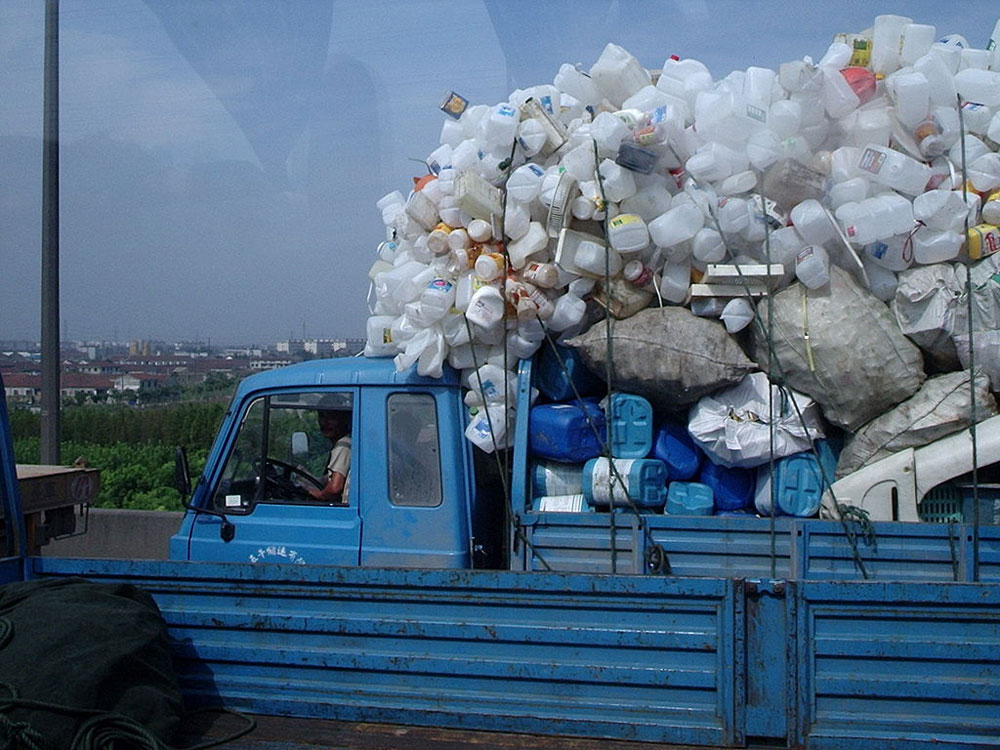
February 19, 2020; Waste 360
What’s a devoted recycler to do now that China is out of the paper and plastics collection business? Cities are reducing or cancelling their recycling programs since the market is gone. Shall we keep on dutifully dumping our pizza boxes and yogurt containers in those bins marked “commingled,” hoping that they don’t get buried as solid waste, dumped in the ocean, sent to the poorest third-world country, or burned in a pyre?
Thanks to China’s National Sword program, the veil has been lifted off recycling’s dirty secret: half of the plastic and much of the paper we deposited in our bins did not go to the local recycling center for eventual reuse but was crammed onto massive container ships and sent to China to be processed under the weakest environmental regulations or dumped to wash down the rivers and ultimately flow to the ocean.
The common narrative for our collapsed recycling market points to China and its 2018 policy to reject our contaminated recyclables. Not true, say both waste experts and environmentalists. Rather, recycling was a dysfunctional industry based on a faulty business model and sloppy processing practices. The US recycling rate has stagnated at about 35 percent since the turn of the century.
Others take their analysis further, blaming an industry dominated by a few waste-hauling conglomerates that, beginning in the early 2000s, lowballed local government contracts and then forced these cities to halt local processing and ship materials far from town for low-quality processing. Equally injurious, these private contractors (e.g., Waste Management, which now serves more than 21 million municipal and business customers) abandoned methodical curbside sorting for the much cheaper single-stream method where all recyclables go into one bin picked up by one trash truck to be packaged into one enormous foul bale. Contamination levels reached 20 to 40 percent. Furthermore, for most of these big companies, operating landfills is the biggest source of their income and thus they lack the incentive to promote the recycling side of their businesses.
Then there’s plastics. Seventy-nine percent of the virgin stuff (non-recycled) ends up in our landfills. There’s at least 8 million metric tons in the ocean. But in these times of cheap and plentiful oil and gas, it’s tough for recycled plastic to compete. One report (albeit from a plastics market research firm) says that the petrochemical industry will likely double its plastic manufacturing capacity from 2016 to 2024.
So, how do we create an accountable, effective, and sustainable recycling industry in the US?
Neil Seldman, cofounder of the Institute for Local Self Reliance and one of the earliest and most persistent advocates of recycling as a local economic development strategy, says we need to get back to the basics—grassroots recycling. He calls it “recycling on local terms” where small curbside collection and commercial enterprises, usually nonprofits, were the norm. Some of these organizations have survived and prospered, like the Ecology Center in Berkeley, EcoCycle in Boulder, and Eureka Recycling in the Twin Cities. Their business model looks very different from that of Waste Management and Republic Services. These recycling enterprises are:
Sign up for our free newsletters
Subscribe to NPQ's newsletters to have our top stories delivered directly to your inbox.
By signing up, you agree to our privacy policy and terms of use, and to receive messages from NPQ and our partners.
- Meticulous. They own their processing plants that are properly scaled and produce clean, raw materials, often maintaining a dual stream recycling process that separates out paper;
- Local. They focus on end markets, primarily in-state, who want long-term supplies of clean, high quality materials and are willing to help finance and upgrade processing facilities;
- Transparent. Their operations and financial reports are open to the public;
- Engaged. They do robust public education and engagement programs; and
- Decent. They pay good wages and benefits for those involved in both processing and transporting.
San Francisco’s laudable recycling and composting program enables it to keep around 80 percent of its waste out of landfills. It’s built on an unusual partnership with Recology, an employee-owned company that has had a monopoly on managing this city’s waste for almost 90 years, not without tough criticism for the no-bid system. But the city defends its practice, avoiding a “race to the bottom.”
Seldman believes there is now sufficient momentum for recycling to go “back to the future,” organized around local, nonprofit, mission-driven organizations; some independent companies; and some joint ventures with local governments.
Others have different solutions for our recycling crisis. The technology fixers point to AI (artificial intelligence) operating an entire recycling facility, “optimizing for highly pure commodities at high efficiency to drive down costs,” reducing labor costs and sorting more accurately. Technology can make recycling work in rural places; one startup uses an Uber-like model to bring collection to places with lower population densities, relying on the ubiquity and underutilization of local pickup trucks and their owners.
The government fix focuses on passing laws in the form of waste reduction targets at the local and state levels or financial incentives like bottle bills that offer cash for recyclables. Countries like South Korea have a national bin system with four categories, all color-coded and easily recognized, so that citizens don’t put recyclables in the wrong places. Sweden has a network of recycling stations no more than 300 meters apart.
There’s the big corporation fixers who focus on the waste stream at the point of production—and look to the Coca-Colas, PepsiCo, Unilever, and H&M, which in 2018 committed to making packaging that is reusable, recyclable or compostable by 2025.
Lastly, there’s those who go to the root of the problem: the necessity of persuading people to buy less stuff. Add a fourth “R,” “refuse,” to the three R’s of “reduce, reuse, recycle.” But that’s a hard sell in the US, where 68 percent of GDP comes from consumer spending and where there’s a company “that knew what you wanted to buy before you did…made shopping recommendations that tapped into your deepest desires [and] made buying completely seamless.”
Clearly, in an ideal world, all approaches are needed to create a waste management model that’s both effective and sustainable. We vote, however, for the approach that prioritizes local control, creates decent jobs, relies on transparency, and makes citizens think beyond the recycle bin.—Debby Warren











